At seventy-three-years-young, there is no stopping Donna Jo Copeland from keeping a small flock of sheep, a few quirky angora goats, and about eleven English angora rabbits on Breezy Manor Farm, located in Mooresville, Indiana. After over five decades of shepherding, she is still fascinated by her fiber animals and loves working with the gift of their wool. Let’s learn more about Donna Jo’s flock-to-sweater process, which proves that you are never too old or too young to enjoy fibers.
The beginning
Donna Jo’s handspinning journey started when she was thirteen years old after she saw someone spinning with a drop spindle.
Donna Jo: “By that time, I was raising English angora rabbits thanks to my grandfather. Once I discovered that you can raise your own fibers and turn them into yarn, there was no going back. There is just something so rewarding about raising animals for their fiber. You have the rewards of their fiber and their companionship. Nowadays, once I have a sheep or goat come here to my flock, I take them for life. In fact, I have one little lady right now, a Shetland who is twenty-five years old. Her name is Essie Mae and she has a beautiful coal-black fleece. She is still going strong and has a nice fleece, even though she is three times the average lifespan of a Shetland.”
Life on the farm
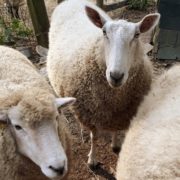
Each one of the fiber animals in Donna Jo’s flock have names. Left to right: Fiona (Romney) and Albert James (Border Leicester).
For fifty-four years, Donna Jo has called Breezy Manor Farm her home. The main house was built sometime in the late 1800s, and when described, it feels almost untouched by the passage of time.
Donna Jo: “It’s still pretty primitive here. I have a wood burning stove and I don’t have a hot water heater. I have a cistern that waters the livestock, which is good. It is a small place. But I have a stream and some little tiny woods. I spend a lot of time outside, and I love it here.”
Handspun sweaters
Over her lifetime, Donna Jo has knit over two dozen sweaters with her own handspun yarns. Her favorite sweater is thirteen years old and called “The Wendy” sweater. This particular sweater came about when the owner of Donna Jo’s favorite fiber mill gifted her a BFL/Wensleydale fleece from their favorite ewe named Wendy.
Donna Jo: “I made a barn sweater with Wendy’s fleece. I blended her wool with mohair from my first angora goat named Molly. In the winter time, I will wear it four days out of the week. It is comfortable. I love the way it fits. I love the history behind it. I had to mend it twice, since it did catch on some barbed wire. But it is still going strong.”
What is a barn sweater?
There are classic fisherman’s sweaters, wooly-pully sweaters, and even tennis sweaters, but have you ever heard of a barn sweater? Loosely defined, a barn sweater is meant to be worn while visiting a barn or accomplishing some other rigorous outdoor activity. It is often a pattern-less knit that uses simple stitches and handspun yarns that are long-wearing. One of the hallmarks of a barn sweater is that it becomes more of a friend and less of a sweater the longer you wear it.
Donna Jo: “I rotate my sweaters constantly. There is always one draped over my rocking chair, just in case I need an extra layer if I feel cold. One of my barn sweaters is over twenty years old, lockspun from a Lincoln Longwool fleece. It is fuzzy, but it goes out to the barn. When I wear my barn sweaters, my sheep come and seem to say: Well, would you look at that – this is me! She’s wearing a sweater made from my wool! I must be her favorite!”
Fleece
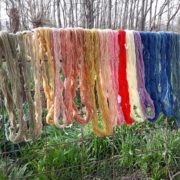
Freshly dyed using dye stuff from her own dye garden, a line-up of Donna Jo’s hand spun drying in the breeze.
Most of Donna Jo’s sweaters are made from the wool of one sheep, and the start of a new sweater begins on shearing day. As her flock is shorn, she looks at each fleece carefully and decides whether she wants to keep it for a sweater project. She then washes that special fleece and dyes it using natural dyes from her own dye garden.
Donna Jo: “I dye my fibers and yarns outdoors in large pots on a woodburning stove. I throw my yarns on a nearby fence to dry. I card my wool after I wash and dye it because I don’t like solid colors. I like variegated, muted colors. I card for colors and texture in the final yarn.”
After her fibers are ready, Donna Jo will start spinning. She is a longtime Ashford fan and has three great wheels. She also loves drop spindle spinning, especially when she is tending to her sheep.
Donna Jo: “I will start spinning all the yarn for a sweater on the same wheel, because each wheel spins a little differently. When I’m stressed or not impressed with the whole world, I light candles on my mantle place. I stand and spin on my great wheel and my whole world gets a lot better.”
Sweater process
It can take Donna Jo a month to create a sweater from fleece to sweater. Her favorite parts of the handspun sweater process include raising fiber animals, washing their fleeces, and dyeing their fiber.
Donna Jo: “There is something special about taking the fiber from an animal and never have it leave the farm. And then becoming something. The fact that the animal is standing and watching the process. If the weather is half decent, I’ll knit outside with the sheep. The sheep cheer me on.”
Donna Jo: “If I’m not doing anything else but farm chores and a sweater, my whole sweater process takes a month. No weaving or extra dyeing. The fleece is washed, dyed, blended, spun, a little bit of sampling, and then I’m just knitting away. I like to use worsted weight yarn on size nine or ten needles. I don’t like thin sweaters and feel warmer in a thicker sweater that has some substance. I like simple sweaters and rarely work from a pattern.”
Donna Jo’s top five tips for a successful handspun sweater project
1) Keep it simple.
Donna Jo: “Keep your timelines – I tell myself that I want to wear something in my lifetime. If it is going to take you five years to create, it might be too complicated.”
2) Spin and enjoy it.
Donna Jo: “There is so much stress in the world. If you spin something, don’t try to be perfect. If you do spin, do it for fun. Perfection is not what we should be about and handspun yarns should have a handspun flavor.”
3) Reward yourself.
Donna Jo: “Every time you get a skein done, have a candy bar or a cup of tea. Embrace every step of the way, sit back, and enjoy it.”
4) Spin all the yarn.
Donna Jo: “Spin all the yarn for your sweater at the same time, because if you start and stop, you’re going to have different yarns and very little consistency. It is not a bad thing, but it is easier to knit with a basket full of yarn, then having to spin and knit at the same time.”
5) Be flexible.
Donna Jo: “Don’t be unrealistic. Give yourself the time to enjoy the process. Listen to the fiber, enjoy the process, and have more fun.”
Parting thoughts
It was an honor to interview a handspinner with such a deep love for her fiber animals and an unwavering dedication to handspinning. When asked if there was anything else she would like to share with readers, Donna Jo sagely said:
“I think one of the more important things for us to do as mavins and crones, as practitioners of this fine art, is to plant as many fiber seeds as we can in younger people. Get them addicted to some part of the handspinning process. Encourage younger people to raise and show wool-producing sheep that will have lambs that will give more wool. We need to share more than we do; children are not sure how to touch wool. I like to give them a chance to touch wool at fiber shows and encourage them to be a part of it. I let them sit at the spinning wheel. Yes, their first yarn may be horrible, but so what? They may have twelve inches of overtwisted yarn, but they did it, and it is okay! We have to keep handspinning going or it is going to be lost.”
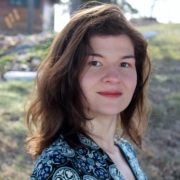 Jacqueline Harp is a freelance writer and multimedia fiber artist who spins, felts, weaves, crochets, and knits in every spare moment possible. She is also a former, certified Master Sorter of Wool Fibers through the State Univ. of N.Y. (Cobleskill) Sorter-Grader-Classer (SGC) Program. Her Instagram handle is @foreverfiberarts.
Jacqueline Harp is a freelance writer and multimedia fiber artist who spins, felts, weaves, crochets, and knits in every spare moment possible. She is also a former, certified Master Sorter of Wool Fibers through the State Univ. of N.Y. (Cobleskill) Sorter-Grader-Classer (SGC) Program. Her Instagram handle is @foreverfiberarts.


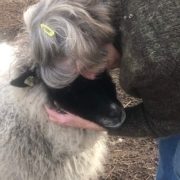
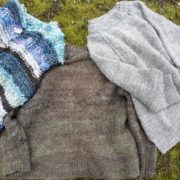




I love this article! Donna Jo Copland’ is such a dear person! Thank you for sharing her story with the fiber communities.